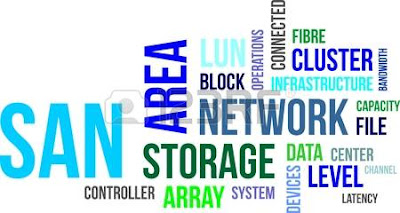This tutorial will help you to learn the basics of Storage Area Network (SAN) and its uses in the current and next generation IT datacenters. The next generation IT datacenters are basically the data centers which can also support cloud computing services (i.e which can host private and public clouds) along with the traditional data center requirements. This tutorial will cover all the basic introduction of the SAN, NAS features along with their physical and logical infrastructure.
Most of these lessons are abstracted from various storage certification guides such as SNIA, EMC, IBM & Comptia to give you the best possible guidelines to become Storage expert. Based upon this tutorials, it is also recommended to get trained on the vendor specific storage arrays if you are planning your career in Storage department.
Chapter 1: Introduction to Storage and DataCenters
1.1 What is DATA and INFORMATION ?
1.2 Where do we store DATA and INFORMATION ?
1.3 Key Characteristics of a Data Center
1.4 IT Data Center Design and its Components
1.5 The next generation IT Data Center Layers
1.6 Compute Systems (server) components and its Overview
1.7 Virtualizing Physical Servers and Applications
1.8 Server-Storage Architecture Overview
1.9 Virtualizing Storage to simplify management
1.10 Server-to-Storage connectivity and network virtualization
Chapter 2: Intelligent Storage Arrays (Systems)
2.1 Types of Storage Devices used in Storage Arrays
2.2 ElectroMechanical Hard Disk Drive (HDD) Overview
2.3 Solid State Drive (SSD) Overview
2.4 What is a Storage Array
2.5 Storage Array Architecture
2.6 What are Intelligent Storage Systems
2.7 Accessing data from the Intelligent Storage Systems
Chapter 3: Introduction to RAID Techniques
3.1 Redundant Array of Independent Disks (RAID) Overview
3.2 Types of RAID Levels
3.3 Overview of RAID 0 and its use cases
3.4 Overview of RAID 1 and its use cases
3.5 Overview of RAID 10 and its use cases
3.6 Overview of RAID 5 and its use cases
3.7 Overview of RAID 6 and its use cases
3.8 What is Hot Sparing ?
3.9 The next generation RAID techniques
Chapter 4: Fibre Channel (FC) SAN and Protocols
4.1 Introduction to SAN Protocols
4.2 Fibre Channel (FC) SAN Components
4.3 Overview of Fibre Channel (FC) SAN Protocol
4.4 Introduction to Fibre Channel (FC) SAN Architecture and port virtualization
4.5 Fibre Channel (FC) Zoning Overview
4.6 Fibre Channel (FC) SAN Topologies
4.7 Introduction to VSAN
4.8 Basic troubleshooting tips for Fibre Channel (FC) SAN
Chapter 5: Fibre Channel over IP (FCIP) SAN and Protocols
5.1 Introduction to IP SAN and their components
5.2 iSCSI Interfaces and Connectivity types
5.3 iSCSI Architecture and Addressing
5.4 Network Considerations for iSCSI SAN Deployment
5.5 Fibre Channel over IP (FCIP) SAN Introduction
Chapter 6: Fibre Channel over Ethernet (FCoE) SAN and Protocols
6.1 The need for a Converged Enhanced Ethernet (CEE) Network
6.2 Functions of Converged Enhanced Ethernet (CEE)
6.3 Introduction to Fibre Channel over Ethernet (FCoE) SAN
6.4 FCoE Connectivity Models
6.5 FCoE Architecture
Chapter 7: Introduction to Block Based Storage Systems (SAN)
7.1 Block Based Storage Systems (SAN) Overview
7.2 Importance of Cache technique in Block Based Storage Systems
7.3 Storage Provisioning and Capacity Optimization Techniques
7.4 Traditional and Virtual Storage Provisioning Overview
7.5 Using Compression techniques in SAN infrastrucutre
7.6 Using Deduplication techniques in SAN infrastrucuture
7.7 Using Sub-LUN Auto Tiering techniques in SAN Infrastructure
Chapter 8: Introduction to File Based Storage Systems (NAS)
8.1 File Based Storage Systems (NAS) Overview
8.2 NAS Arrays Overview & Types of NAS Arrays
8.3 NAS File Sharing Protocols
8.4 Overview of NAS Arrays
8.5 File Level Storage (NAS) Virtualization and Storage Tiering
Chapter 9: Introduction to Object Based Storage Systems (OSD)
9.1 Object Based Storage Systems (OSD) Overview
9.2 Key Features of Object Based Storage Systems
9.3 How Data is stored and Retrieved from Object Based Storage Systems ?
9.4 Using Object Based Storage Systems in Cloud Environments
Chapter 10: Introduction to Unified Storage Systems and Software Defined Data centers (Storage & Networking)
10.1 Unified Storage Systems Overview
10.2 Software Defined Storage Overview
10.3 Software Defined Storage (SDS) Architecture
10.4 Software Defined Networking (SDN) Overview
10.5 How storage is provisioned in Software Defined Storage Environments
Chapter 11: Backup and Archive
11.1 Protecting the data for short term (Backup)
11.2 Data Backup Architecture and Components
11.3 Types of Data Backup Methods
11.4 Types of Backup Techniques
11.5 Data Backup for the Mobile Devices
11.6 Protecting the Data for Long Term (Archive)
11.7 Taking Backup and Archive to Cloud Storage
Chapter 12: Introduction to Data Replication Techniques
12.1 Data Replication Overview & Types of Replication
12.2 Server or Host Based Replication Overview
12.3 Storage System Based Replication Overview
12.4 Network Based Replication Overview
12.5 Data Migration and Disaster Recovery As a Service (DRAaS) Solutions
Chapter 13: Storage Management & Data Security
13.1 Introduction to Storage Infrastructure Management
13.2 Introduction to the key Storage Management Operations
13.3 Factors affecting SAN performance
13.4 Introduction to Information Security
13.5 Information Security Threats and Security Controls Overview








could we download this by any chance all in one
ReplyDelete